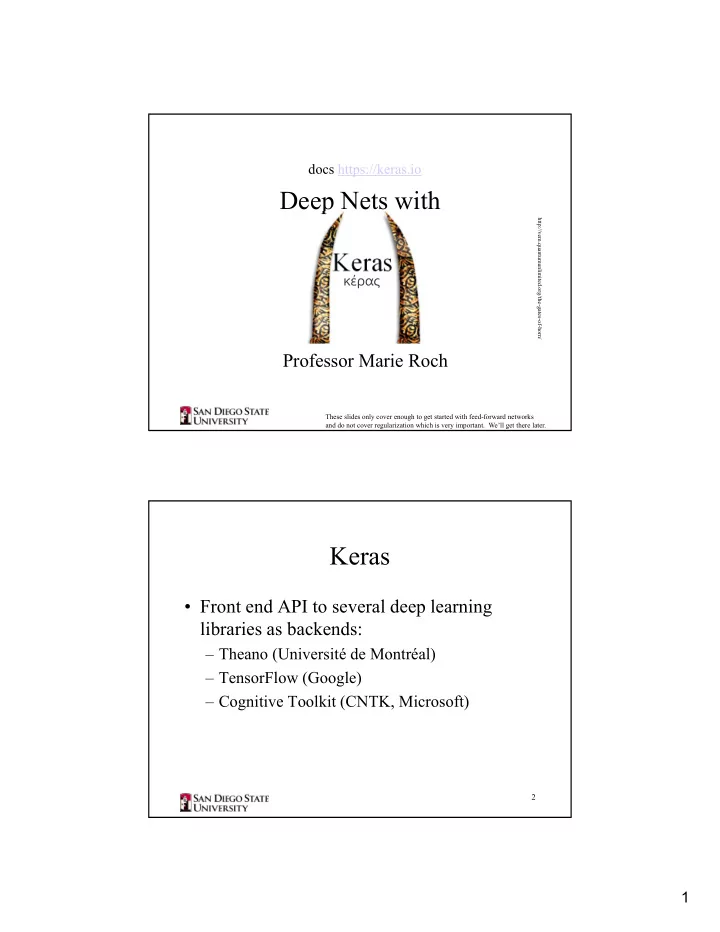

docs https://keras.io Deep Nets with http://vem.quantumunlimited.org/the-gates-of-horn/ Keras κέρας Professor Marie Roch These slides only cover enough to get started with feed-forward networks and do not cover regularization which is very important. We’ll get there later. Keras • Front end API to several deep learning libraries as backends: – Theano (Université de Montréal) – TensorFlow (Google) – Cognitive Toolkit (CNTK, Microsoft) 2 1
Keras • Advantages – High-level specification of neural nets and other computation. – Transparent GPU vs non-GPU programming – Rapid specification 3 Keras concepts : Models Models can be: – Specified: Functionality is specified by invoking model methods, e.g. add a new layer of N nodes. – Compiled: A compile method writes the back- end code to generate the model – Fitted: Optimization step where weights are learned – Evaluated: Tested on new data 4 2
Keras concepts : Models We can use a Sequential model for a feed- forward network from keras.models import Sequential model = Sequential() 5 Keras concepts: Layers • Layers can be added to a model • Dense layers – compute f(W T x+b) – user specifies • number of units • input/output tensor shapes (tensors are N-dimensional arrays) • activation functions • other options… 6 3
A Keras model from keras.models import Sequential from keras.layers import Dense model = Sequential() # Three category prediction with 2 hidden layers # and 30 features, categorical output (3 categories) model.add(Dense(10, activation='relu', input_dim = 30)) model.add(Dense(10, activation='relu', input_dim = 10)) # Output probability of each category model.add(Dense(3, activation='softmax', input_dim = 10)) 7 from keras.utils import np_utils # model definition from previous slide… # Specify type of gradient descent, loss metric, and # measurement metric model.compile(optimizer = "Adam", loss = "categorical_crossentropy", metrics = [metrics.categorical_accuracy]) # Not needed; prints architecture summary model.summary() # We need examples and labels for supervised learning # examples: NxM numpy.array where N=# samples, M=# features examples = get_features() # you write this 8 4
# Nx1 vector of our 3 categories labels = get_labels() # you write this # Our network uses a Multinoulli distribution to # output one of three choices. Our labels are scalars, # we need to convert these to vectors: # 0 ‐ > [1 0 0], 1 ‐ > [0 1 0], 2 ‐ > [0 0 1] # this is sometimes called a “one ‐ hot” vector from keras.utils import np_utils onehotlabels = np_utils.to_categorical(labels) # train the model # 10 passes (epochs) over data, mini ‐ batch size 100 model.fit(examples, labels, batch_size=100, epochs=10) 9 Using a trained model • To predict outputs results = model.predict(examples) – results is Nx3 probabilities – What are the following? • np.sum(results, axis=1) • np.argmax(results, axis=1) 10 5
Using a trained model • To evaluate performance # Returns list of metrics results = model.evaluate(test_examples, test_labels) # model.metrics_names tells us what was measured # here: ['loss', 'categorical_accuracy’] print(results[1]) # accuracy # In some fields, it is common to report error: 1 ‐ accuracy 11 To install SciKit: conda install scikit-learn N-fold cross validation # Create a plan for k ‐ fold testing with shuffling # of examples using SciKit’s StratifiedKFold # http://scikit ‐ learn.org/stable/modules/generated/sklearn.model_selection.StratifiedKFold.html # Randmize examples within each fold kfold = StratifiedKFold(n_folds, shuffle=True) # Generate indices that can be used to split into training # and test data, e.g. examples[train_idx] for (train_idx, test_idx) in kfold.split(Examples, Labels): # normally, we would gather results about each fold train_and_evaluate(examples, one_hot_labels, train_idx, test_idx) 12 6
An architecture for building networks • Data-driven network construction • Store constructors and their arguments in a list of tuples e.g. network = [ (Dense, [in_N], {‘activation’: ‘relu’}) (Dense, [out_N], {‘activation’: ‘softmax’})] • Tuple: – layer name – list of positional arguments – dictionary of named arguments 13 An architecture for building networks Model construction is easy: • Create a sequential model • Loop over tuples – Call the layer type to construct a layer • Use * to pass in positional args: *tuple[1] • Use ** to treat dictionary as named args: **tuple[2] – Add the layer to the model 14 7
Other types of models • Not all models are sequential: Ronneberger et al.’s U-Net MICCAI 2015 15 Complicated architectures Use the functional API # This returns a tensor inputs = Input(shape=(N_inputs,)) # a layer instance is callable on a tensor, and returns a tensor x = Dense(N_width, activation='relu')(inputs) x = Dense(N_width, activation='relu')(x) predictions = Dense(10, activation='softmax')(x) # This creates a model that includes the Input layer and three Dense layers model = Model(inputs=inputs, outputs=predictions) model.compile(optimizer='rmsprop', loss='categorical_crossentropy’, metrics=['accuracy’]) model.fit(data, labels) # starts training 16 8
Monitoring tool for tensor graphs 17 18 9
TensorBoard from keras.callbacks import TensorBoard … tensorboard = TensorBoard( # Write to logs directory, e.g. logs/30Oct-05:00 log_dir="logs/{}".format(time.strftime('%d%b-%H%M')), histogram_freq=0, write_graph=True, # Show the network write_grads=True # Show gradients ) # train the net model.fit(examples, onehotlabels, epochs=epochs, callbacks=[loss, tensorboard]) Then start tensorboard from the command prompt: tensorboard –logdir logs/30Oct-05:00 TensorBoard 1.5.1 at http://localhost:6006 (Press CTRL+C to quit) Point chrome at the URL and off you go… 19 There are lots of tutorials if you want to use advanced features. 10
Recommend
More recommend